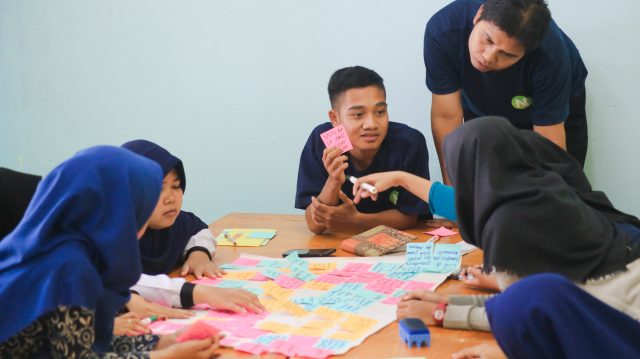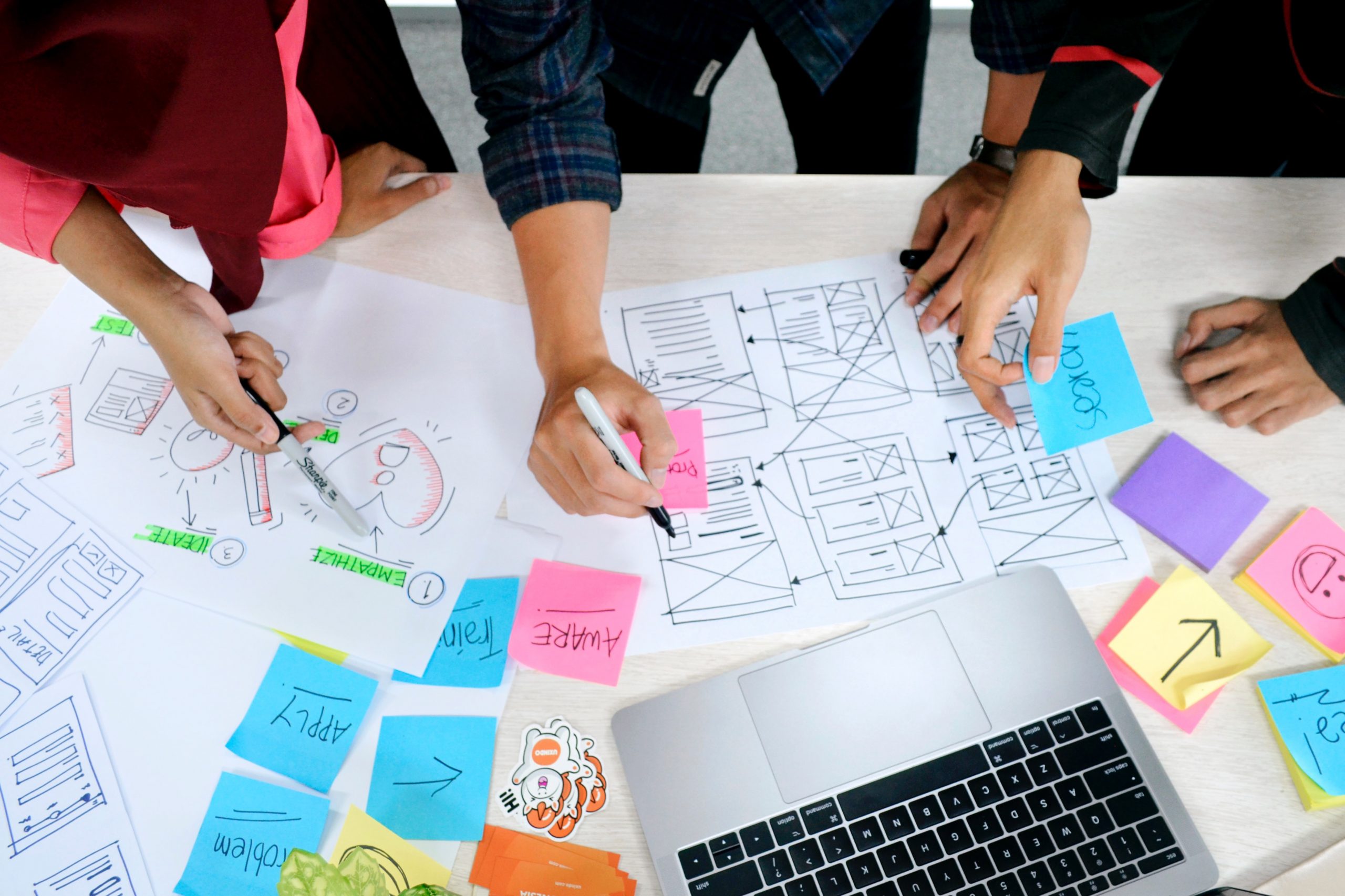22 de julho de 2021.
Find the english version in the end of the article.
Minha experiência trabalhando em projetos de impacto social nos últimos anos me ensinou que esses projetos apenas são eficientes quando estão firmemente alinhados às perspectivas das pessoas afetadas por eles. Vi inúmeros exemplos de projetos que não engajaram de verdade as comunidades impactadas, resultando em desperdício de recursos e até em impacto negativo ao invés de positivo. Preconceitos, falta de atenção a agentes importantes e falta de abordagem holística às necessidades e expectativas dos beneficiados resultaram em projetos infrutíferos.
Neste artigo, introduzo o conceito de Design Thinking, que procura resolver alguns problemas através da colaboração, empatia e repetição. Também destaco algumas lições específicas que essa metodologia me trouxe enquanto gerente de projeto de impacto social. Espero que elas sejam úteis para você também!
O que é o Design Thinking?
De acordo com a Interaction Design Foundation, Design Thinking (definição em português) é “uma metodologia de design que oferece uma abordagem baseada em soluções para resolver problemas”. É especialmente útil quando uma pessoa ou um grupo precisa encontrar uma solução para um problema complexo, no qual as causas são desconhecidas, mal definidas ou até mesmo profundamente enraizadas nos modelos mentais da nossa sociedade.
Esta metodologia é útil ao enfatizar “as necessidades humanas envolvidas, ao reformular o problema por meio de uma visão mais centrada no ser humano, criando diversas ideias em sessões de brainstorming, e adotando uma abordagem mais prática em prototipagem e testes.”

Para que possamos aplicar este modelo de pensamento a projetos de impacto social, o mais importante que você precisa saber é que ele vai colocar as necessidades das pessoas no centro de qualquer solução criada e implementada. Uma abordagem centrada no ser humano vai considerar três passos cíclicos.
O primeiro passo, “fazer com que se envolvam”. O Design Thinking funciona melhor quando as soluções são desenvolvidas em conjunto “com” as pessoas que serão impactadas pelas ações, e não apenas “para” essas pessoas.
Fazer isso requer:
Envolvimento com as comunidades locais para entender os problemas socioambientais através de suas perspectivas;
Estabelecer canais de comunicação direta e indireta com elas, como entrevistas, pesquisas, conversas informais, visitas de campo, entre outros;
Aumento da conscientização sobre o problema que você deseja abordar, envolvendo outros agentes importantes relacionados a ele;
Criação mecanismos de feedback constantes e claros, para que você possa continuar a aprimorar sua ideia regularmente.
O segundo passo, “entender suas necessidades”. À medida que você conseguir que as pessoas se envolvam no processo de criar um projeto, você será capaz de entender melhor quais são as necessidades e expectativas da comunidade. De acordo com Bradshaw, existem 4 tipos principais de necessidades sociais:
Necessidade normativa: uma necessidade social que é identificada por um especialista no assunto;
Necessidade comparativa: uma necessidade social que é identificada ao comparar o estado de uma comunidade/local/grupo de pessoas a outro de características similares;
Necessidade sentida: uma necessidade (ou desejo) social que é percebido pelas observações ou sentimentos de um indivíduo;
Necessidade expressa: uma necessidade social que é claramente expressada através de um pedido ou afirmação das pessoas que são diretamente afetadas por ela. Também é referenciada como “necessidade sentida transformada em ação”.
Você pode reunir informações sobre todas essas necessidades através de pesquisa quantitativa ou qualitativa, e também por entrevistas com agentes relevantes, conforme mencionado anteriormente.
E o terceiro passo é “projetar para suas necessidades”. Ao aplicar a metodologia de Design Thinking, seu projeto deverá ser fortemente alinhado às necessidades dos beneficiários. Através dessa base, você pode cocriar protótipos, testá-los e reajustá-los. Tenha em mente que o processo não termina aqui; você deverá continuar mantendo a comunidade e os agentes envolvidos, enquanto passa por todas as fases do projeto.
Agora que você tem uma visão geral das etapas do processo de Design Thinking, vamos analisar algumas lições específicas que ele proporciona a gerentes de projetos de impacto social como eu e você.

Lição 1: O problema é mais importante que a sua solução
O Design Thinking nos mostra que entender o problema através da perspectiva dos nossos beneficiários é mais importante do que provar que estamos certos. Se nós desenharmos um projeto e pularmos diretamente para a implementação, certamente deixaremos escapar aspectos relevantes pela perspectiva dos usuários, em termos de suas necessidades, expectativas, experiências, motivações e outros elementos que podem influenciar suas interações com o projeto.
Como “Design Thinkers”, nós devemos investigar ao máximo as causas do problema que queremos resolver antes de avançarmos para a solução. Isto irá nos prevenir de implementar soluções que são ineficazes ou que possam ter um impacto negativo para as pessoas que estamos ajudando.
Lição 2: Empatia deve ser o núcleo do seu projeto
Para Daniel Goleman e Paul Ekman, existem 3 tipos de empatia:
Empatia Cognitiva – que é baseada na compreensão racional das perspectivas e necessidades de outros;
Empatia Emocional – que se manifesta quando nós compartilhamos as emoções dos outros em relação a uma determinada situação;
Empatia Compassiva – que desponta não apenas quando nos conectamos racional e emocionalmente com os outros, mas também quando nos colocamos à disposição para apoiá-los.
Para que a metodologia de Design Thinking funcione propriamente, designers de projetos devem buscar entender racionalmente a perspectiva dos usuários, conectar-se emocionalmente com eles e, por fim, procurar ajudá-los (se necessário). A empatia é desenvolvida por meio da curiosidade. Os designers de projeto devem estar curiosos sobre a história, os bastidores, as motivações, as preocupações dos usuários e qualquer outra coisa relacionada às suas visões do problema socioambiental a ser abordado.
Empatia, portanto, é o processo de compreender a experiência subjetiva de uma pessoa sendo curioso sobre o ponto de vista dela e compartilhando de seu estado emocional, enquanto mantemos um estado observador (e curioso) durante toda a criação do projeto e processos de implementação.
Lição 3: confie em sua criatividade
Encontrar soluções para questões socioambientais complexas, definitivamente, não é uma tarefa fácil. Mesmo depois de engajar totalmente as partes interessadas e consultar os beneficiários, ter ideias e a coragem de implementá-las pode ser assustador. Frequentemente, o resultado do seu projeto pode ser diferente de tudo o que já foi feito antes, e é preciso muita Confiança Criativa para inovar.
O fundador da IDEO, empresa global de design, e criador da Stanford d.school, David Kelley, argumenta que a Confiança Criativa está disponível para qualquer pessoa, mesmo aquelas que não se consideram do “tipo criativo”. Para ele, as pessoas são naturalmente criativas, devendo “deixar que suas ideias voem”. O processo de Design Thinking mostra resultados incríveis quando as pessoas permitem que sua criatividade floresça. Você vai ver!
Lição 4: Diga “sim e…”!
Outra lição que o processo de Design Thinking me ensinou é confiar nas ideias dos meus colegas e estimulá-las, ao invés de apontar o que pode dar errado imediatamente.
Como um processo inerentemente colaborativo, o Design Thinking exige que todos os membros da equipe envolvidos no design do projeto compartilhem suas ideias. Sessões de brainstorming podem até se tornar irrealistas e ideias surreais podem surgir; isso faz parte do processo. Deixe que essas ideias venham! Quando elas aparecerem, diga “sim e…” para somar seus próprios pensamentos aos de seu colega e criar algo novo. Você pode se surpreender!
Lição 5: refaça, refaça, refaça
Mesmo seguindo todas essas dicas e lições, cometeremos erros. Perderemos detalhes importantes, esqueceremos de validar algumas de nossas premissas e negligenciaremos aspectos importantes de nossos projetos. A boa notícia é que a iteração faz parte do processo de Design Thinking e é uma das principais lições que aprendi com ele.
Como Design Thinkers, nós nunca podemos presumir que temos todas as respostas. Nosso espírito investigativo e curioso continuará a nos guiar enquanto prototipamos, testamos e implementamos projetos. Portanto, devemos sempre usar os nossos aprendizados para tentar de novo, de novo e de novo. Cada vez que tentamos, nos aproximamos da solução que procuramos. Falhar e tentar novamente faz parte do processo. Encare com leveza e intencionalidade. O Design Thinking significa que nunca realmente terminamos, então o processo de prototipagem e teste pode continuar à medida que você continua a desenvolver seu projeto.
Concluindo, tenha em mente que a criação de projetos de impacto social é mais eficaz quando os beneficiários estão no centro. Mantenha uma abordagem de aprendiz em relação ao seu projeto, permaneça crítico sobre seu próprio trabalho e seja honesto quanto aos resultados de sua ação.
Clique abaixo para aprender mais através do Manual de Design Thinking da Global Changemakers.
Design Thinking Lessons for Social Impact Projects
My experience working with social impact projects in the past years has taught me that such projects are only effective when tightly aligned with the perspectives of the people affected by them. I have seen countless examples of projects that did not properly engage the communities impacted by them, resulting in wasted resources and even creating a negative impact instead of a positive one. Cultural biases, lack of attention to important stakeholders, and lack of a holistic approach to the beneficiaries’ needs and expectations result in ineffective projects.
In this article, I will introduce the concept of Design Thinking, which seeks to address some of those issues through collaboration, empathy and iteration. I will also highlight some specific lessons that this methodology has brought me as a social impact project manager. I hope they become useful for you as well!
What is Design Thinking?
According to the Interaction Design Foundation, Design Thinking is “a design methodology that provides a solution-based approach to solving problems”. It is especially useful when a person or a group of people needs to find a solution to a complex problem – one whose causes are unknown, ill-defined or even deeply rooted in society’s mental models.
This methodology helps by highlighting “the human needs involved, by re-framing the problem in human-centric ways, by creating many ideas in brainstorming sessions, and by adopting a hands-on approach in prototyping and testing”.
In order for us to apply this thinking model to social impact projects, the most important thing you need to know is that it will put people’s needs at the center of any solution created and implemented. A human-centered approach will consider three cyclic steps.
First, “getting them engaged”. Design Thinking works best when solutions are developed “with” the people who will be impacted by them, not “for” them. Doing so requires:
Engaging with local communities to understand the social/environmental problems from their perspective;
Setting direct and indirect communication channels with them, such as interviews, surveys, informal conversations, field visits, among others;
Raising awareness about the issue you want to address, by engaging other important stakeholders with it and
Creating constand and clear feedback mechanisms, so you can continue to improve on your idea on a regular basis.
Secondly, “understanding their needs”. Once you get them engaged in the process of designing a new project, you will be able to better understand what their needs and expectations are. According to Bradshaw, there are four main types of social needs:
Normative Need: A social need that is identified by a professional specialist on the topic.
Comparative Need: A social need that is identified by comparing the state of a community/location/group of people to another of similar characteristics.
Felt Need: A social need/want that is perceived by an individual’s observations and/or feelings.
Expressed Need: A social need that is clearly expressed through a request or affirmation by the people directly affected by it. Also referred to as “felt need turned into action”.
You can collect information on all of those needs based on quantitative and qualitative research, as well as interviews with relevant stakeholders, as mentioned above.
Thirdly, “designing for their needs”. When applying the Design Thinking methodology, your project’s design should be tightly aligned with your beneficiaries’ needs. Based on the, you can co-create prototypes, test them, and iterate them. Keep in mind that the process does not end here. You should continue to keep the community and stakeholders involved and you move on to all project phases.
Now that you have an overview of what the Design Thinking process entails, let’s look into some specific lessons it provides to social impact project managers like you and me.
Lesson 1: The Problem Matters More than Your Solution
Design Thinking shows us that understanding the problem from our beneficiaries’ eyes matters more than proving ourselves right. If we design a project and jump straight into implementing it, we will certainly miss key aspects of the users’ perspectives, in terms of their needs, expectations, experiences, motivations and other elements that might influence their interaction with the project. As Design Thinkers, we should investigate the causes of the problem we want to solve as much as possible before jumping into a solution. This will prevent us from implementing solutions that are ineffective or that have a negative impact on the people we are serving.
Lesson 2: Empathy Should Be at the Core of Your Project Design
For Daniel Goleman and Paul Ekman, there are three types of Empathy:
Cognitive Empathy, which is based on the rational understanding of others’ perspectives and needs.
Emotional Empathy, which happens when we share others’ emotions regarding a particular situation.
Compassionate Empathy, which happens when we not only rationally and emotionally connect to others, but make ourselves available to support them.
For the Design Thinking methodology to work well, project designers should seek to rationally understand the users’ perspective, emotionally connect with them and ultimately seek to help them (if needed). Empathy is developed through curiosity. Project designers should be curious about users’ story, background, motivations, concerns, and anything else related to their views of the social/environmental problem to be addressed.
Empathy, therefore, is the process of understanding a person’s subjective experience by being curious about their point of view and sharing their emotional state, while maintaining an observant (and curious) status throughout the project design and implementation processes.
Lesson 3: Trust Your Creativity
Finding solutions for complex social/environmental issues is definitely not an easy task. Even after thoroughly engaging stakeholders and consulting with beneficiaries, generating ideas and having the guts to implement them might be daunting. Often, your project might come out differently than anything that has been done before, and it takes a lot of Creative Confidence to innovate.
IDEO founder and Stanford d.school creator David Kelley argues that Creative Confidence is available to any person, even those who do not consider themselves the “creative type”. For him, people are naturally creative, and should “let their ideas fly”. The Design Thinking process shows incredible results when people allow their creativity to flourish. You’ll see!
Lesson 4: Say “yes and”!
Another lesson that the Design Thinking process taught me is the value of trusting my colleagues’ ideas and adding to them, instead of pointing out what could go wrong right away.
As an inherently collaborative process, Design Thinking requires all team members involved in project design to share their ideas. Brainstorming sessions might even become unrealistic and surreal ideas might come up. That’s part of the process. Let those ideas come! When they do, say “yes and” to sum your own thoughts to your colleague’s thoughts and create something new. You might get surprised!
Lesson 5: Iterate, iterate, iterate
Even when following all these tips and lessons, we will make mistakes. We will miss important details, forget to validate some of our assumptions, and overlook important aspects of our projects. The good news is that iteration is part of the Design Thinking process, and one of the main lessons I have learned from it.
As Design Thinkers, we should never assume to have all the answers. Our investigative and curious spirit will continue to drive us as we prototype, test and implement projects. Therefore, we should always use our learnings to try again, and again, and again. Each time we try, you’re closer to the solution we are looking for. Failing and trying again is part of the process. Approach it with lightness and intentionality. Design thinking means we are never quite finished, so the process of prototyping and testing can carry on as you continue to evolve your project.
In conclusion, keep in mind that designing social impact projects is more effective when beneficiaries are at the center of them. Keep a learners’ approach to your project, remain critical about your own work and be honest about your impact results.
Click below to learn more through the Global Changemakers Design Thinking Toolkit.




